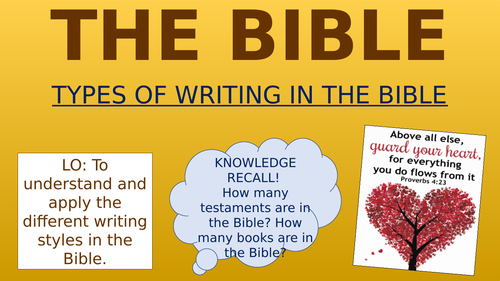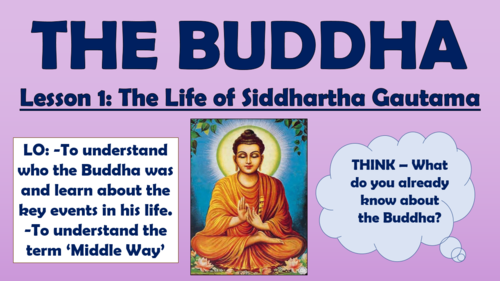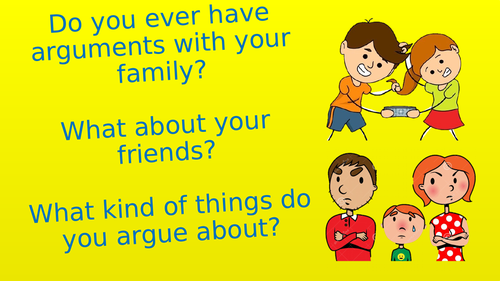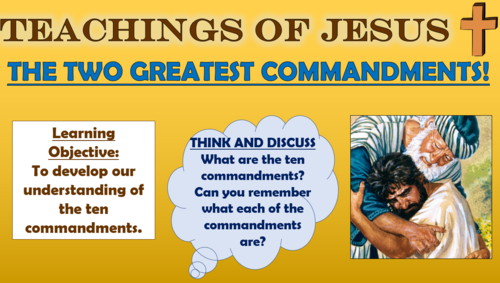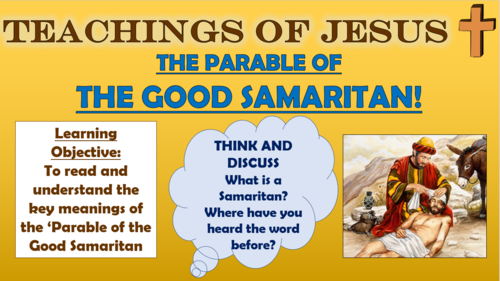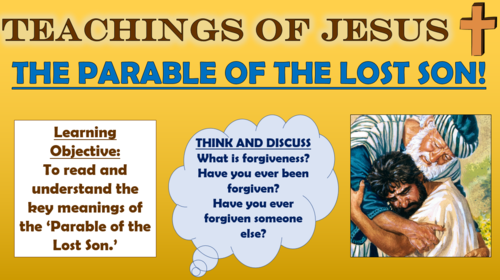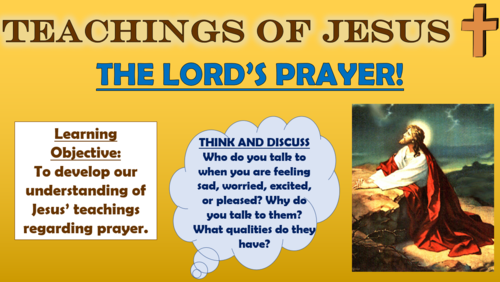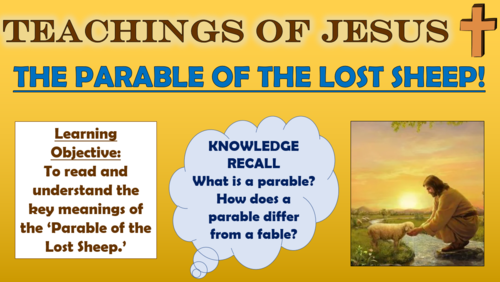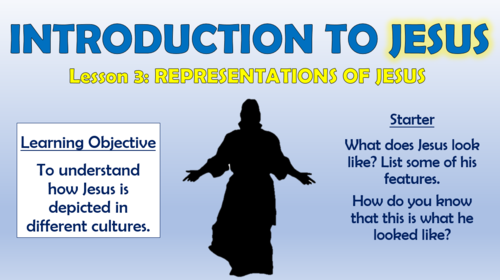
3k+Uploads
1905k+Views
2237k+Downloads
Religious education

The Bible - Types of Writing in the Bible!
In this engaging and informative lesson, students learn about the different types of writing in the Bible, consider how these different writing forms get across key messages, and apply this knowledge in creating their own thoughtful texts. They learn through:
-Recalling and remembering how to reference different sections of the Bible;
-Acting as ‘Bible Detectives’, follwing references in order to find different styles of writing;
-Analysing how different styles of writing add to meanings/ messages;
-Considering important messages and lessons that they have been given in their own lives, and applying knowledge of different writing styles to contribute to a ‘Class Bible’;
-Evaluating their ‘Class Bible’ through thought-provoking reflection questions;
This resource pack contains a comprehensive and colourful 17-slide Powerpoint, which guides teachers and students through the learning activities. Challenge activities are provided in order to enrich learning for higher-attaining learners.
A part of the lesson includes using Bibles, so you will need enough for at least one per group in your class.
In the past, I have used this lesson with children from across Key Stage 2 - the key learning is aligned with national expectations for RE, and also the content prescribed by most diocese regions. All images are licensed for commercial use, and are cited on the final slide.

The Buddha - The Life of Siddhartha Gautama!
In this engaging lesson, students are introduced to who Siddhartha Gautama was, and learn how he became the Buddha. They also begin to discuss the ‘Middle Way’, and consider how these ideas can be applied to modern life.
The learning is guided by a clear and colourful PowerPoint presentation, which guides students through the following step-by-step journey:
-Knowledge harvesting - gauging what children already know about the Buddha;
-Watching a short video (hyperlinked) about the life of Siddhartha Gautama;
-Explaining the key events in his life, using a storyboard template;
-Discussing what is meant by the ‘Middle Way’, and how this helped Gautama to find enlightenment;
-Thinking about how they can apply the ideas of the ‘Middle Way’ to their own lives;
-Considering a deeper thinking extension question;
-Completing a plenary to assess their understanding.
This resource pack contains a comprehensive Powerpoint, alongside an eye-catching worksheet.
In the past, I have used this lesson with children from across Key Stage 2 - the key learning is aligned with curriculum expectations for RE, and also the content prescribed by most diocese regions. All images are licensed for commercial use.

Introducing Buddha's Image!
This interesting session aims to introduce children to some key images of the Buddha, providing them with an opportunity to decode some of the key meanings within pictures and sculptures. Children learn that there are many different representations of the Buddha, aiming to portray different aspects of Siddhartha Gautama’s life and character.
Children learn through:
-Acting as detectives, inferring and deducing the hidden meanings within pictures;
-Considering the key concept of ‘balance’, and understanding how this is a key feature of the Buddhist religion;
-Applying some of the key concepts to their own lives.
Included is a PowerPoint presentation, differentiated group activity sheets, and a comprehensive lesson plan.
Images are cited in the final slide of the presentation.
Word documents (in the zip file) are also included in PDF to ensure no issues with formatting between computers.

KS1 RE - The Life of a Vicar!
In this engaging lesson, students develop their understanding of the roles of vicars. They consider their routines and actions, and how vicars live their daily lives. It is great as a standalone lesson, or as a part of a unit on ‘special ways of living.’
The learning is guided by a clear and colourful PowerPoint presentation, which guides students through the following step-by-step journey:
-Thinking about the definition of a vicar (and how this differs from the more general definition of a priest;
-Introducing children to the daily life of vicars, including discussing their many roles and responsibilities, through watching an interesting and age-appropriate video;
-Answering questions to check their understanding of the roles of vicars;
-Completing a storyboard (using a provided template) to show the daily routine of vicars;
-Learning about the different clothes worn by vicars, before drawing and labelling a vicar in uniform;
-Considering questions that they would ask to a vicar if they were given the opportunity (you could email these to your local vicar, or even better, invite them in for a Q and A session);
-Self-reflecting on the extent to which they feel they have met the learning objectives.
This resource pack includes the comprehensive PowerPoint presentation (15 slides) the template for the storyboard, and the hyperlink for the video explaining about the daily life of a vicar. There is everything that you need here to teach the lesson.
In the past, I have used this lesson with children from across Key Stage 1 - the key learning is aligned with curriculum expectations for RE, and also the content prescribed by most diocese regions. All images are licensed for commercial use.

Sawm - The Fourth Pillar of Islam!
In this engaging and comprehensive lesson, students are introduced to the fourth pillar of Islam - Sawm, the act of fasting during the period of Ramadan.
Children learn through collating their collective prior knowledge, learning key facts, watching an interesting video (hyperlinked) and demonstrating their understanding through various tasks, including designing their own Iftar plate. They also consider their own personal spirituality, discussing concepts such as self-discipline and control.
The lesson is tried and tested, and is easy for teachers and students to follow. It contains a comprehensive 17-slide Powerpoint which offers a step-by-step guide throughout the lesson. The template is also provided for the Iftar task (in both Word and PDF). Challenge activities are provided in order to enrich learning for higher-attaining learners.
In the past, I have used this lesson with children in upper Key Stage 2 (years 5 and 6). The key learning is aligned with regional expectations for RE, and also the content prescribed by most diocese regions. All images are licensed for commercial use, and are cited on the final slide.

RE - Introduction to Islam!
In this engaging and comprehensive lesson, students are introduced to the religion of Islam. They find out a number of key introductory facts about Islam, including:
-Who follows Islam;
-Some of the things that they believe;
-Where and how they worship;
-Their sacred places and texts.
Children learn through collating their collective prior knowledge, watching an interesting video (hyperlinked) and recording the key information, and exploring more information about the Qur’an, mosques and the Prophet Muhammad using a list of approved websites. They conclude by comparing what they have found out about Islam with what they know about Christianity.
The lesson is tried and tested, and is easy for teachers and students to follow. It contains a comprehensive 15-slide Powerpoint which offers a step-by-step guide throughout the lesson. Challenge activities are provided in order to enrich learning for higher-attaining learners.
In the past, I have used this lesson with children from across Key Stage 2 - the key learning is aligned with national expectations for RE, and also the content prescribed by most diocese regions. All images are licensed for commercial use, and are cited on the final slide.
Bundle Sale

RE - Special Ways of Living - Big Bundle!
This bundle contains all 6 of the ‘Special Ways of Living’ RE lessons, in addition to the ‘Special Ways of Living’ knowledge organiser.
These engaging and informative lessons develop KS1 children’s understanding of how people of different faiths choose to live their lives in special ways. There are two lessons each focusing on the Christian, Buddhist and Muslim faiths respectively.
The lessons should be taught in the following order:
Christianity - The Good Samaritan (belief in compassion/ forgiveness);
Christianity - The Life of a Vicar
Buddhism - How Buddhists Live
Buddhism - Buddhist Monks and Nuns
Islam - Muslim Prayer
Islam - The Holy Month of Ramadan
In each lesson, the learning is guided by a clear and colourful PowerPoint presentation, which guides students through a step-by-step learning journey. There are also all of the reading and worksheets included - everything that you need to teach the lessons.
In the past, I have used these resources with children from across Key Stage 1 - the key learning is aligned with curriculum expectations for RE, and also the content prescribed by most diocese regions. All images are licensed for commercial use.
Bundle Sale

Personal Development Assemblies Huge Bundle!
These fun and original assemblies have been designed aid children in developing their skills of:
Compassion
Honesty
Resilience
Humility
Celebrating differences
Thankfulness
Patience
Peace
Creativity
All of the assemblies are tried and tested, and each has been really well received in the past.
The slides are visually engaging and well-presented, and the subject matter is tailored to the interests and needs of young people. For example, there are references to scenarios and dilemmas that they themselves might find themselves in, in order to help them to make the right choices in their own lives.
There are also fun role-play activities, beautiful, thought-provoking videos exemplifying each theme, and various discussion activities regarding how to show the skills in different areas of their own lives. No further resources are required, everything that you need to present the assemblies is included.
Each set of slides are fairly self-explanatory, but I’ve included guidance notes for each assembly to assist the speaker. Hope that you find this useful!

Zakah - The Third Pillar of Islam!
In this engaging and comprehensive lesson, students are introduced to the third pillar of Islam - Zakah.
Children learn through collating their collective prior knowledge, watching an interesting video (hyperlinked) and answering comprehension questions about Zakah. They then develop their understanding by learning about why Muslims give Zakah and how it benefits others, before comparing these ideas with their own personal views on generosity and charity.
The lesson is tried and tested, and is easy for teachers and students to follow. It contains a comprehensive 18-slide Powerpoint which offers a step-by-step guide throughout the lesson. Challenge activities are provided in order to enrich learning for higher-attaining learners.
In the past, I have used this lesson with children in upper Key Stage 2 (years 5 and 6). The key learning is aligned with regional expectations for RE, and also the content prescribed by most diocese regions. All images are licensed for commercial use, and are cited on the final slide.

The Theme of Peace - Assembly
This fun and original assembly assists children in understanding the value of peace, through:
Understanding what peace is, and recognising why it is important;
Looking at examples of behaviour that is peaceful and not peaceful and considering what can be done to promote peace;
Learning strategies to demonstrate peacefulness in their own lives.
This session is tried and tested, and has always been really well received in the past. The slides are visually engaging and well-presented, and the subject matter is tailored to the interests and needs of young people.
The session also includes a link to a powerful and engaging video, showing children how their small input can help to create peace in the world. Furthermore, there are interesting scenarios (with scripts provided) that enable children to consider how to act peacefully in different situations. Various discussion prompts are also presented, to enable children to understand how peace can be a force for good in their own lives.
The slides are fairly self-explanatory, but I’ve included to pages of notes to assist the speaker. Hope that you find this useful!

Teachings of Jesus - The Two Greatest Commandments!
In this engaging lesson, students develop their understanding of the ten commandments. They particularly consider what Jesus communicated as ‘the two greatest commandments’ (‘Love God’ and ‘Love thy Neighbour’).
The learning is guided by a clear and colourful PowerPoint presentation, which guides students through the following step-by-step journey:
-Recalling each of the ten commandments and translating them into modern English;
-Knowledge recall - remembering key facts about Jesus’ life and teaching;
-Ranking the commandments in order of those that they feel are most important;
-Reading and discussing Jesus’ lesson on the most important commandments;
-Considering the messages that they can take for their own lives from this message;
-Creating 10 commandments for the modern world;
-Self-reflecting on the extent to which they feel they have met the learning objective.
The resource pack includes everything you need to teach the lesson, including the comprehensive PowerPoint presentation and the Bloom’s Taxonomy worksheet (provided in both Word and as a PDF). Just download and teach!
In the past, I have used this lesson with children from across Key Stage 2 with minor adaptations for age - the key learning is aligned with curriculum expectations for RE, and also the content prescribed by most diocese regions. All images are licensed for commercial use.

Teachings of Jesus - The Parable of the Good Samaritan!
In this engaging lesson, students read and interpret ‘The Parable of the Good Samaritan.’
The learning is guided by a clear and colourful PowerPoint presentation, which guides students through the following step-by-step journey:
-Knowledge recall - remembering key facts about Jesus’ life and teaching;
-Defining the meaning of the word ‘Samaritan’ and gaining a basic understanding of the historical relationship between Jews and Samaritans;
-Reading and interpreting the parable through comprehension questions, and deciphering its key meanings;
-Considering the messages that they can take for their own lives from this parable;
-Researching how some charities have continued in the spirit of this parable today;
-Self-reflecting on the extent to which they feel they have met the learning objective.
The resource pack includes everything you need to teach the lesson, including the comprehensive PowerPoint presentation and the parable worksheet (provided in both Word and as a PDF). Just download and teach!
In the past, I have used this lesson with children from across Key Stage 2 with minor adaptations for age - the key learning is aligned with curriculum expectations for RE, and also the content prescribed by most diocese regions. All images are licensed for commercial use.

Teachings of Jesus - The Parable of the Lost Son!
In this engaging lesson, students read and interpret ‘The Parable of the Lost Son’ (also known as the Parable of the Prodigal Son).
The learning is guided by a clear and colourful PowerPoint presentation, which guides students through the following step-by-step journey:
-Defining what ‘forgiveness’ means;
-Knowledge recall - remembering key facts about Jesus’ life and teaching;
-Understanding how it can be difficult, but important, to forgive;
-Watching an engaging, age-appropriate video of the parable;
-Demonstrating understanding of the parable through Bloom’s Taxonomy-style activities, including defining, remembering, inferring, sequencing, analysing, applying and creating activities;
-Considering the messages that they can take for their own lives from this parable;
-Self-reflecting on the extent to which they feel they have met the learning objective.
The resource pack includes everything you need to teach the lesson, including the comprehensive PowerPoint presentation and the Bloom’s Taxonomy worksheet (provided in both Word and as a PDF). Just download and teach!
In the past, I have used this lesson with children from across Key Stage 2 with minor adaptations for age - the key learning is aligned with curriculum expectations for RE, and also the content prescribed by most diocese regions. All images are licensed for commercial use.
Bundle Sale

Subject Foundations in EYFS - Knowledge Organisers Bundle!
These clear, detailed and visually-appealing resources help to detail and categorise the EYFS foundation learning in each of the primary curriculum subject areas
It is an important resource for EYFS teachers and parents, but also subject leaders, to aid them in the development of a clearly-mapped and well-sequenced subject curriculum across the school.
This organiser groups the subject-related learning into the relevant EYFS areas of learning (e.g. Understanding the World, Expressive Arts and Design, Communication and Language, etc.)
The resources are designed to be printed onto A3, and are provided as both PDF and Word documents (so that you can edit if you want to). All images used are licensed for commercial use and are cited on a separate document (included).

Mary, Mother of Jesus - Collective Worship Session!
This fun and original collective worship session aims to guide children towards building their knowledge of Mary, mother of Jesus, through:
-Gathering what they already know about Mary;
-Learning about the annunciation of Mary, through reading an engaging and thought-provoking script;
-Answering comprehension questions based on the ideas and events of the annunciation;
-Considering Mary’s response and actions after learning that she would be the mother of Jesus;
-Studying examples of Mary’s devotion and love towards Jesus, through engagement with religious artworks and Bible quotations;
-Discussing the Christian values that Mary demonstrated throughout her life;
-Singing a hymn about the Mother Mary (hyperlinked);
-Closing with a prayer related to the Mother Mary.
The session includes a 16-slide presentation, the script for the ‘anunciation’ section (in both Word and PDF) and the hyperlink to the hymn. No further resources are required, everything that you need to present the assembly is included.
This assembly was originally delivered to all of the children in a primary school (KS1 and KS2), although with suitable adaptations it could also be suitable for students in KS3.

RE - Sikhism - The Ten Gurus!
In this engaging lesson, students develop their understanding of Sikhism through learning about the ten human gurus.
The learning is guided by a clear and colourful PowerPoint presentation, which guides students through the following step-by-step journey:
-Recalling key information about the life and beliefs of Guru Nanak;
-Researching the nine subsequent Sikh Gurus, using a structured template;
-Sharing their findings with their classmates;
-Considering the key messages communicated by each of the Sikh gurus and justifying which they feel are the most important;
-Completing a creative task in which they make a Sikh Guru timeline;
-Self-reflecting on the extent to which they feel they have met the learning objectives.
This resource pack includes the comprehensive PowerPoint presentation (17 slides) and the research template. There is everything that you need here to teach the lesson.
In the past, I have used this lesson with children from across Key Stage 2 - (predominantly upper KS2) the key learning is aligned with curriculum expectations for RE, and also the content prescribed by most diocese regions.

Teachings of Jesus - The Lord's Prayer!
In this engaging lesson, students develop their understanding of Christian prayer. The lesson places a particular emphasis upon the Lord’s Prayer.
The learning is guided by a clear and colourful PowerPoint presentation, which guides students through the following step-by-step journey:
-Considering who we confide in when we need to talk to someone, and understanding that Christians can confide in God;
-Knowledge recall - remembering key facts about Jesus’ life and teaching;
-Watching an engaging, age-appropriate video about how Christians pray and demonstrating understanding through answering questions;
-Using the worksheet provided to read and comprehend the Lord’s prayer, answering the key questions provided;
-Self-reflecting on how the teachings may influence their own lives;
-Considering the extent to which they feel they have met the learning objective.
The resource pack includes everything you need to teach the lesson, including the comprehensive PowerPoint presentation and the ‘Lord’s Prayer’ worksheet (provided in both Word and as a PDF). Just download and teach!
In the past, I have used this lesson with children from across Key Stage 2 with minor adaptations for age - the key learning is aligned with curriculum expectations for RE, and also the content prescribed by most diocese regions. All images are licensed for commercial use.

Teachings of Jesus - The Parable of the Lost Sheep!
In this engaging lesson, students read and interpret ‘The Parable of the Lost Sheep.’
The learning is guided by a clear and colourful PowerPoint presentation, which guides students through the following step-by-step journey:
-Knowledge recall - remembering key facts about Jesus’ life and teaching;
-Discussing why Jesus’ parables continue to give important messages;
-Watching an engaging, age-appropriate video of the parable;
-Interpreting the parable through comprehension questions, and deciphering its key meanings;
-Using the storyboard template provided to demonstrate their understanding of the parable and its morals;
-Considering the messages that they can take for their own lives from this parable;
-Self-reflecting on the extent to which they feel they have met the learning objective.
The resource pack includes everything you need to teach the lesson, including the comprehensive PowerPoint presentation and the storyboard template (provided in both Word and as a PDF). Just download and teach!
In the past, I have used this lesson with children from across Key Stage 2 with minor adaptations for age - the key learning is aligned with curriculum expectations for RE, and also the content prescribed by most diocese regions. All images are licensed for commercial use.

The Bible - Interpretations of the Bible!
In this engaging and informative lesson, students learn how Christians may interpret the Bible differently. They learn about the meaning of ‘liberal’ and ‘fundamentalist’ Christians, and understand how these two viewpoints influence interpretations of different Bible stories. They learn through:
-Recalling and remembering foundation contextual facts about the Bible;
-Defining the word ‘interpretation’ and understanding that people can interpret the same things differently;
-Learning about the differences in beliefs between fundamentalist Christians and liberal Christians;
-Watching the story of Jesus’ baptism (link included) and establishing how fundamentalist and liberal Christians may interpret different sections of the story;
-Considering how their work on different interpretations may influence the way that they see and behave towards other people with different ideas to themselves.
This resource pack contains a comprehensive and colourful 15-slide Powerpoint, which guides teachers and students through the learning activities. Challenge activities are provided in order to enrich learning for higher-attaining learners. A link to the video is also included (slide 9).
In the past, I have used this lesson with children from across Key Stage 2 - the key learning is aligned with national expectations for RE, and also the content prescribed by most diocese regions.
The resource is also suitable for home learning
All images are licensed for commercial use, and are cited on the final slide.

Introducing Jesus - Representations of Jesus!
In this engaging lesson, students develop their understanding of how Jesus Christ is visually depicted in paintings, focusing on facial expression, body language, his effect on his immediate environment, and other features. They also begin to look at how Jesus has been depicted over time and in different cultures.
The learning is guided by a clear and colourful PowerPoint presentation, which guides students through the following step-by-step journey:
-Personal Spirituality - considering how people (including themselves) can be represented;
-Understanding how no one today knows for sure how Jesus looked, and the paintings that we see of him are artists’ representations;
-Analysing how Jesus is represented in some famous paintings of different events in his life;
-Creating their own painting of Jesus from an event in his life, considering how Jesus himself is represented.
This resource pack contains a comprehensive Powerpoint, alongside an eye-catching, and helpful worksheet.
In the past, I have used this lesson with children from across Key Stage 2 - the key learning is aligned with curriculum expectations for RE, and also the content prescribed by most diocese regions. All images are licensed for commercial use.

